Jewish-Roman cuisine, typical of the Ghetto of Rome, is the result of the blending of flavours and traditions of the Jewish and Roman cultures that have coexisted for centuries in the same area. This mutual influence has enriched and inspired the cuisine of the Ghetto of Rome, resulting in a unique culinary experience. The cuisine of the Ghetto of Rome differs slightly from the Roman cuisine of the rest of the city. Apart from often being kosher, it is also because of the Middle Eastern and Spanish influences that have contributed to the creation of distinctive dishes.
Table of Contents
Characteristics and origins of Jewish-Roman cuisine in the Ghetto of Rome
The Ghetto of Rome is the district of the capital where Jews historically lived for centuries, for a long time, with restrictions that also influenced their diet. Jewish cuisine originated from the biblical tradition of kosher food. Specific food categories, such as rabbit or pork, are not allowed. Meat and dairy products, on the other hand, cannot be eaten in the same meal nor cooked or processed together.
PLAN YOUR TRIP TO ROME
Save money on entrance fees and transportation costs with the Roma Pass. This City Card offers free entry to two attractions, as well as discounts at other museums and archaeological sites, including the Colosseum, the Roman and Imperial Forums, the Capitoline Museums, the Ara Pacis and other must-see.
To stay connected in Italy, remember to buy an Airalo eSim online, with data and phone coverage for your trip to Rome.
Jewish-Romanesque cuisine, as well as Jewish cuisine in general, has been influenced by the different cultures with which Jews have come into contact over the centuries. In particular, Spanish, Middle Eastern, North African and, above all, Italian. On the other hand, Roman cuisine is very varied, influenced by the cultures that have ruled the city over the centuries, and has a great variety of fresh ingredients.
In the Ghetto of Rome, the cuisine uniquely combines these two culinary traditions, creating dishes with an intense flavour and rich history. Restrictions imposed on the Jews over the centuries, limiting the types of meat and fish available for consumption by the population, influenced Jewish-Roman cuisine. These restrictions have led to innovative and tasty dishes, such as the famous carciofi alla giudia, a fried artichoke dish different from classic Roman cooking.
Today, the cuisine of the Ghetto of Rome is a culinary heritage that represents the history and culture of Rome and its Jewish community. A combination of flavours, stories and traditions handed down from generation to generation, creating unique and delicious dishes that continue to amaze and delight the palate of tourists and the curious.
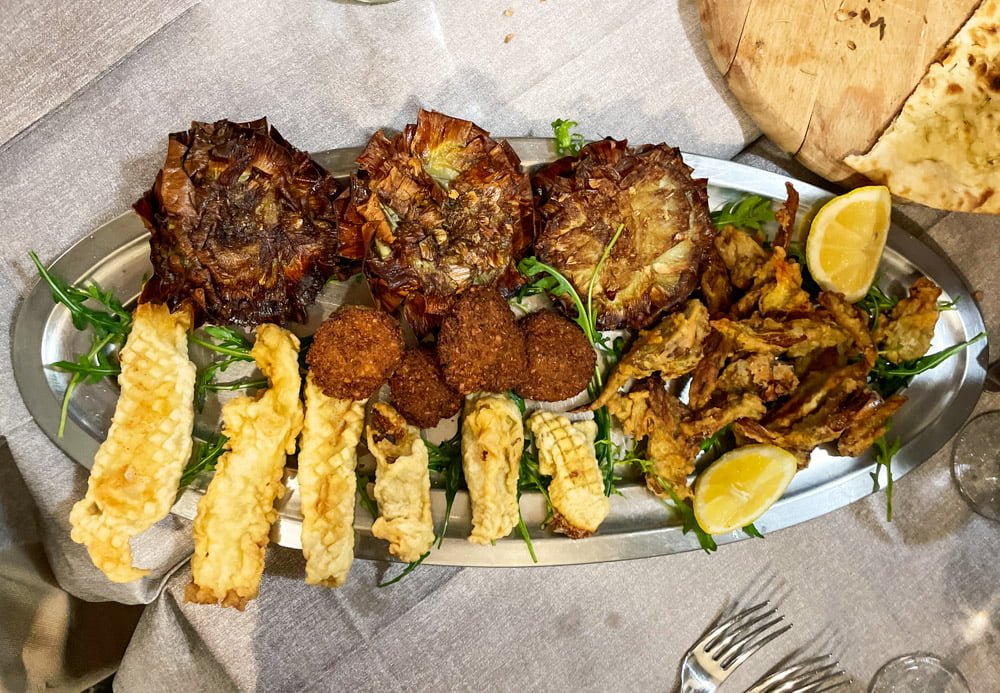
Traditional dishes of Jewish-Roman cuisine
The Jewish-Roman cuisine offers a wide range of tasty traditional dishes that have become world-famous thanks to word-of-mouth among tourists in Rome. The best-known dishes are probably artichokes alla giudia, stuffed zucchini flowers and battered cod. The real gastronomic experience is to go to a restaurant in the Ghetto of Rome and order the dishes on the menu that inspire you the most.
Artichokes alla giudia: the iconic dish of Jewish-Roman cuisine
Carciofi alla giudia is one of the most iconic dishes of Jewish-Roman cuisine and a symbol of Jewish tradition in Rome. This dish consists of fried whole artichokes, served golden and crispy. The taste is unique, with leaves crispy as chips on the outside and soft and delicious on the inside.
The preparation of artichokes alla giudia requires a lot of care and precision. To get the right degree of crispiness, they must be cleaned, cut precisely and fried in olive oil at a high temperature for a few minutes. The receipt of carciofi alla giudia allows to cook artichokes, very popular in Roman cuisine, according to kosher rules. The dish of artichokes alla giudìa is today one of Rome’s most loved and famous dishes, by Romans and visitors alike.
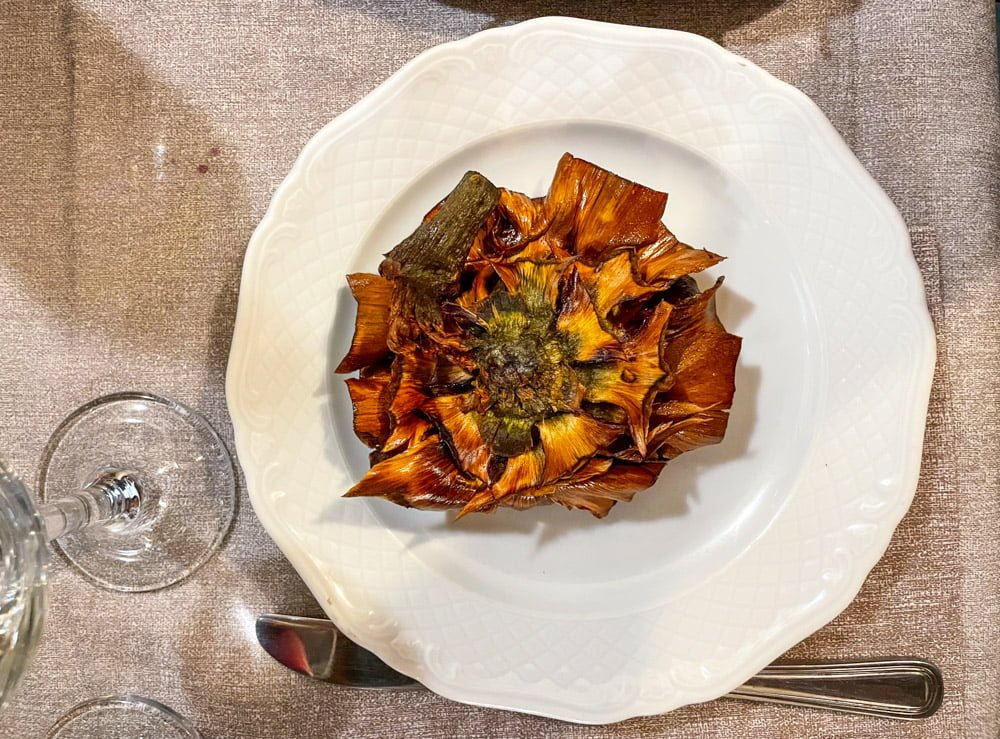
How to clean and cook artichokes alla giudia and alla Romana
During my last trip to Rome, I discovered, thanks to the patient explanations of Mr Giuseppe, one of the restaurant’s owners, Il Giardino Romano, that the secret to a delicious artichoke dish is the choice and the cut. Depending on the season, one can use Roman artichokes, which arrive at the end of March, or Sardinian and Apulian violet artichokes. Still, they must be strictly fresh from the market.
The artichokes should not be too open but ajar so as not to have hair inside. Then they must be spirally cleaned, removing all the inedible parts, but without removing too much because the outer leaves are the ones that will become tasty and crunchy once dipped in oil.
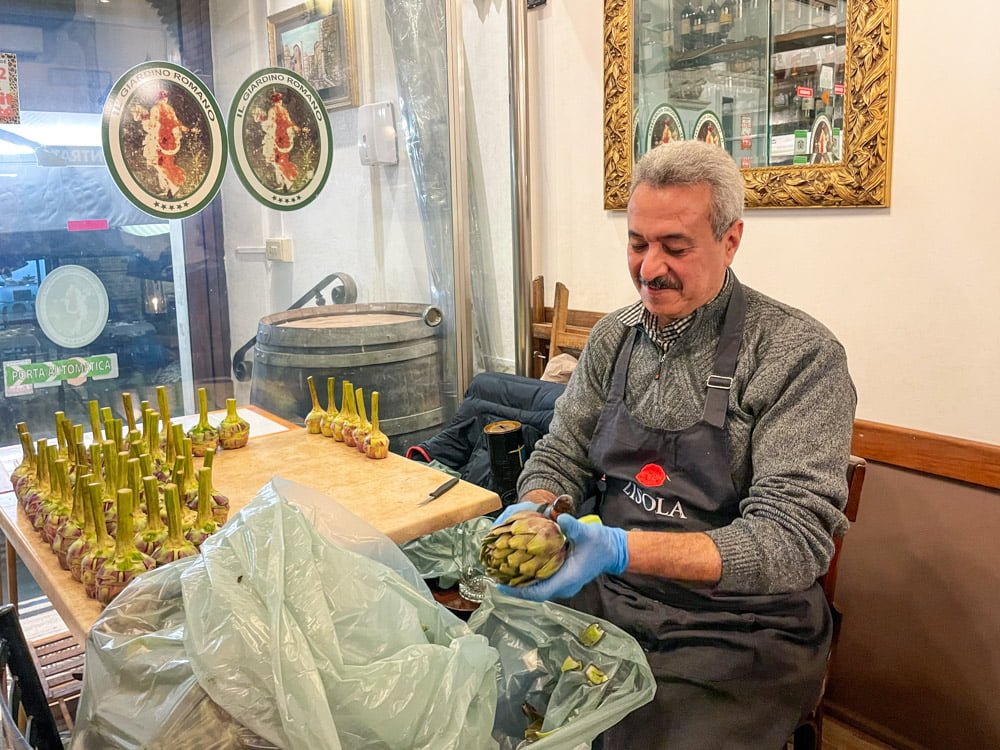
Of the artichoke, one eats the white part of the leaves, not the green part. To arrive at an artichoke cleaning technique as precise as Mr Giuseppe’s takes years of experience recognising where a leaf is edible or too rigid. If you’d like to try, use a small, sharp knife.
Depending on the preparation, the cleaning of the artichokes follows a different cut. When preparing artichokes alla romana, you should remove more leaves than when preparing alla giudia. The starting size of the artichoke is the same, but after cutting, the Roman-style artichoke remains smaller.
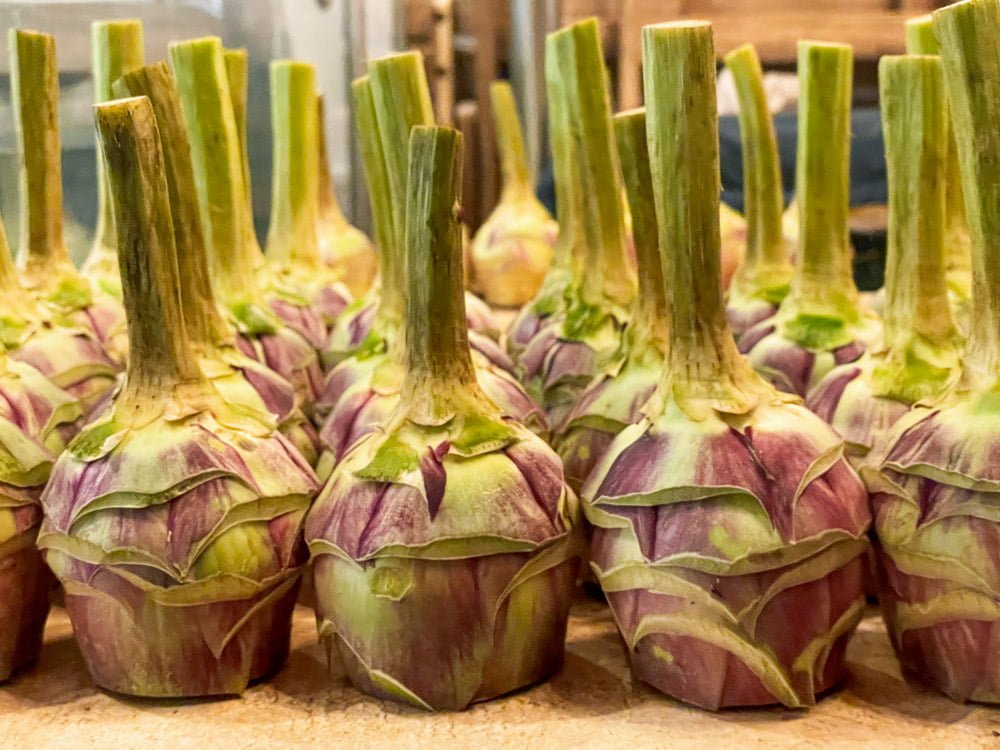
Concia di courgette
A traditional starter of Jewish-Roman cuisine is concia di zucchine, prepared exclusively with local vegetables. Only Roman courgettes, which have a typical bitterish flavour, are used to prepare the concia. The courgettes are cut lengthwise and fried, then arranged in layers in an oven dish and seasoned with basil, garlic and vinegar.
Baccalà
Fried salt cod is another typical dish of the Jewish-Roman cuisine of the Rome Ghetto. Although very popular in many Mediterranean cuisines, baccalà, or dried codfish, the Jewish-Roman version has a different preparation.
After soaking for at least 24 hours, it is cleaned and cut into strips, then dipped in a batter of flour, eggs, salt and pepper, and fried in hot oil until golden and crispy. Fried cod in Judeo-Roman cuisine is often served as an appetiser or main dish, accompanied by vegetables or salad.
Batter-filled zucchini flowers
Jewish Roman cuisine is distinguished by its great variety of vegetarian dishes, and among these are stuffed zucchini flowers, usually served as an appetiser. Squash blossoms are prepared with a filling of ricotta (or mozzarella) cheese, eggs, Parmesan cheese, salt and pepper, then dipped in batter and fried in hot oil until golden and crispy.
Their crispness on the outside and softness on the inside, together with their delicate and light flavour, make them a popular dish of Jewish-Roman cuisine that I recommend you try during a visit to the Ghetto of Rome.
Desserts in the Ghetto of Rome
Among the best-known desserts you can enjoy in the Ghetto of Rome is the ricotta and sour cherry tart, a fragrant and creamy cake with a crumbly tart and a filling of fresh ricotta, eggs, sugar and candied sour cherries, a type of cherry similar to sour cherries. Another Jewish-Roman dessert I recommend is almond paste biscuits and other ricotta-based tarts, including ricotta and chocolate cake.

Where to eat traditional Jewish-Roman dishes in the Ghetto of Rome
In the Ghetto di Roma, there are many restaurants and bakeries where you can enjoy authentic Jewish-Roman cuisine. Traditional restaurants are all in a very small area, including several kosher activities for those who follow the rules of the Jewish diet.
Below, I list the most popular restaurants I have tried personally or recommended by friends and fellow bloggers. The dining quality in the Ghetto of Rome is very high, so you cannot go wrong. All the restaurants in the Ghetto prepare traditional Jewish and Roman dishes, and you will find the famous carciofo alla giudia everywhere.
Il Giardino Romano
The first restaurant in the Jewish Ghetto that I would recommend is Il Giardino Romano, where I have eaten really well. Each dish reflects tradition and care in preparation, with forays into Middle Eastern and North African cuisine, thanks to the passion for food of the two owners, Medhat and Giuseppe, Egyptian and Italian, respectively.
On the menu, you will find delicious falafel alongside stuffed squash blossoms, but above all, the fantastic artichokes alla giudia. The artichoke is the speciality of the Il Giardino Romano restaurant. You will also find it in the first courses, such as the cacio e pepe pasta with artichokes, a tasty variation on tradition.
I recommend accompanying your dishes with a bottle of wine with the Il Giardino Romano restaurant label, designed to best accompany the dishes on the menu. Finally, if you visit the Jewish Ghetto in spring or summer, I suggest you book a table in the lovely outdoor garden. It is decorated in the Ancient Rome style from which the restaurant takes its name.
Il Giardino Romano
Via del Portico d’Ottavia, 18

Kosher street food in the Ghetto of Rome
Another place I tried during my trip to Rome was the Antico Forno Urbani, one of the oldest historic bakeries in the capital, where I stopped for street food. Its specialities are white and red Roman-style pizzas, a thin and crispy pizza called ‘scrocchiarella‘ in Rome. Still, you can also find focaccia, lingue di pizza (long shape pizza), pizza al taglio (square cut pizza), bread and pastries.
Antico Forno Urbani (kosher)
Piazza Costaguti, 30
For desserts, Pasticceria Boccione is an institution in the Ghetto of Rome, famous for its ricotta and sour cherry tart. Plus, only women work there. There is no sign and only a tiny shop window, but you can recognise this bakery by the outside line. The interior is very small, and you will find a few products, including almond paste biscuits, some Jewish holiday sweets and several ricotta cakes.
The reason to visit is the ricotta and sour cherry cake, prepared in a unique way compared to the rest of Rome. While in all the other restaurants, bakeries and pastry shops, the ricotta tart is more solid, almost like a cake, the one at Pasticceria Boccione is very soft and more delicate in taste. It’s a real treat, worth trying despite the higher prices than you might expect when looking at the shop from the outside.
Pasticceria Boccione (kosher)
Via del Portico d’Ottavia, 1
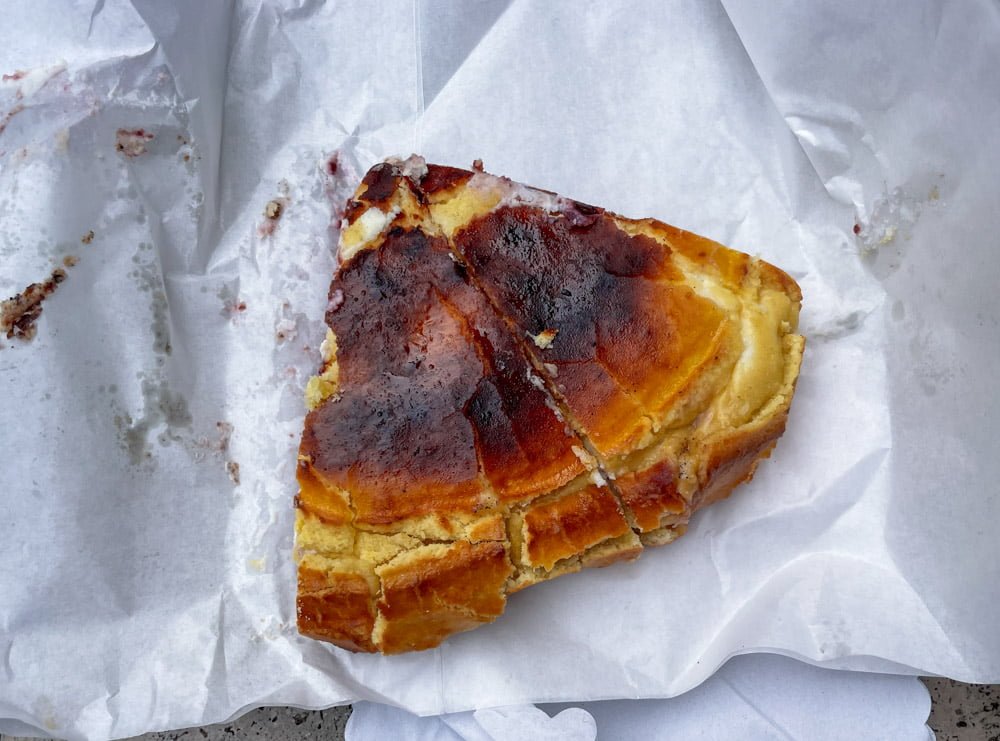
Jewish-Roman kosher restaurants
There are also many kosher restaurants in the Ghetto of Rome, which cook according to the dictates of the Jewish religion. The difference is not so much in the dishes as in the preparation because observant Jews in the kitchen cannot use the same tools to cook meat or dairy products.
In kosher restaurants, therefore, you are bound to find vegan or vegetarian dishes as an alternative to meat or dairy dishes unless the establishment is so large that it can have a double kitchen with different utensils. For example, on menus where you find abbacchio, a traditional Roman meat, there is no pasta cacio e pepe, made with cheese, and vice versa.
In addition, again due to the Jewish rule of kasherut, in Hebrew כַּשְׁרוּת, typical Roman dishes such as pasta alla gricia or alla carbonara, are prepared slightly differently, without pork, a forbidden food in the Jewish religion.
Nonna Betta (meat restaurant)
Via del Portico d’Ottavia, 16
Bellacarne (meat restaurant)
Via del Portico d’Ottavia, 51
Yotvatà (milk restaurant)
Piazza Cenci, 70
Ba Ghetto (chain of kosher restaurants – milk and meat restaurants)
Via del Portico D’Ottavia, 57,59,61,63,65
Renato al Ghetto
Via del Portico d’Ottavia, 5
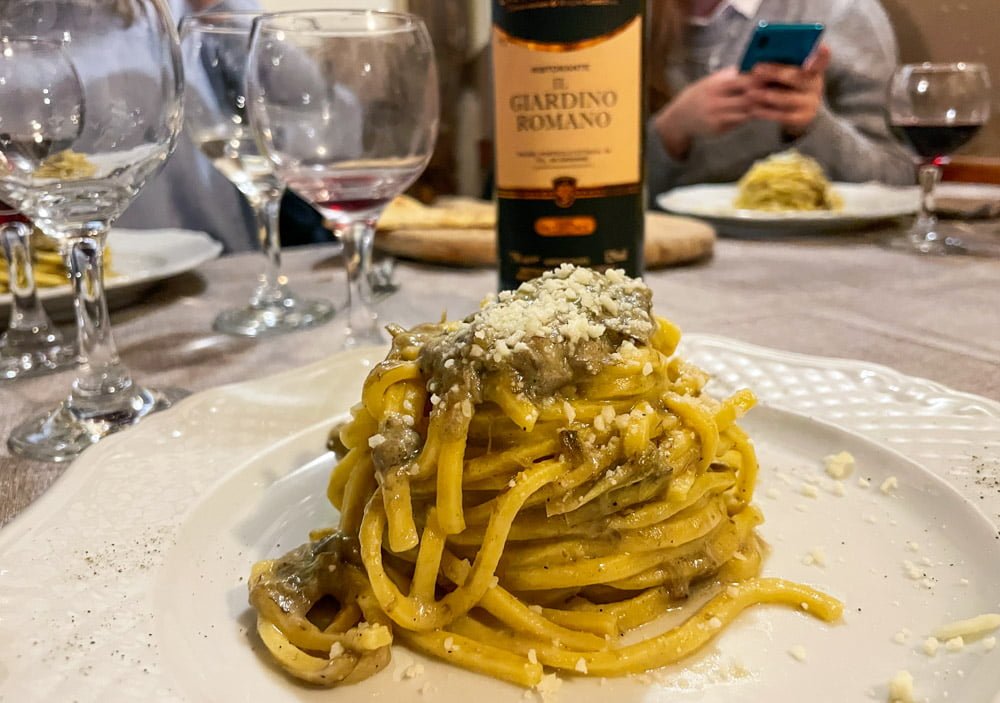
As you discovered in this article, a gastronomic itinerary in Rome’s Jewish Ghetto is a journey that weaves together history and flavours influenced by local and Middle Eastern traditions. From artichokes alla giudia to stuffed courgette flowers, the flavours tell a story that spans time. Feel free to comment if you already know these delicious dishes or if you will try them on your next trip to Rome.
